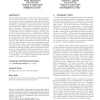Free Online Productivity Tools
i2Speak
i2Symbol
i2OCR
iTex2Img
iWeb2Print
iWeb2Shot
i2Type
iPdf2Split
iPdf2Merge
i2Bopomofo
i2Arabic
i2Style
i2Image
i2PDF
iLatex2Rtf
Sci2ools
GECCO
2010
Springer
2010
Springer
Transfer learning through indirect encoding
An important goal for the generative and developmental systems (GDS) community is to show that GDS approaches can compete with more mainstream approaches in machine learning (ML). One popular ML domain is RoboCup and its subtasks (e.g. Keepaway). This paper shows how a GDS approach called HyperNEAT competes with the best results to date in Keepaway. Furthermore, a significant advantage of GDS is shown to be in transfer learning. For example, playing Keepaway should contribute to learning the full game of soccer. Previous approaches to transfer have focused on transforming the original representation to fit the new task. In contrast, this paper explores transfer with a representation designed to be the same even across different tasks. A bird’s eye view (BEV) representation is introduced that can represent different tasks on the same two-dimensional map. Yet the problem is that a raw two-dimensional map is highdimensional and unstructured. The problem is addressed naturally by in...
| Added | 19 Jul 2010 |
| Updated | 19 Jul 2010 |
| Type | Conference |
| Year | 2010 |
| Where | GECCO |
| Authors | Phillip Verbancsics, Kenneth O. Stanley |
Comments (0)

